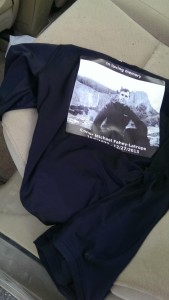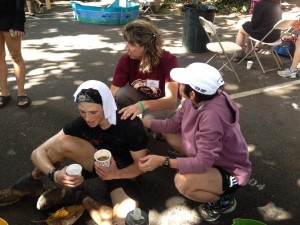This will be an unusual race report. It comes with a trigger warning. It discusses suicide in some detail, and vomit in some quantity.
I won’t say a lot about what makes the HURT 100 so beautiful, so hard, and so rewarding. You can read my report from last year for that. I will say that I was extremely excited to know that I would be running it again this year, and that I considered last year’s finish the hardest thing I had ever done.
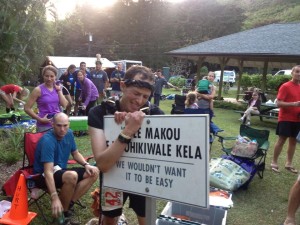
Along with so many other things, that all changed approximately three weeks and five hours before the conch blew to start the race. Early on the morning of December 27 2013, or very late December 26 if you prefer, Conor Michael Fahey-Latrope killed himself. He was a close friend to me and a companion in adventures both well and ill conceived across the millenia.
I spent most of that night (or the next if you prefer) and the next few days at the scene, trying as best I could to help his bereaved wife and child, to sort through his possessions, to make That Phone Call to a number of our old friends. That was the hardest thing I’ve ever done, but unlike running and finishing HURT I had no choice at all.
I thought about withdrawing from HURT. Funeral details were up in the air for a while, and it seemed like everything would naturally be chaos for weeks, months, forever. I was only just recovering from a minor knee injury and undoubtedly undertrained. A week after Conor’s death, under the strain of it all, I sprained my back changing into my gym clothes. I was drinking too much for the first time in eight years. I was a wreck all around, I knew it, and a stupid footrace didn’t seem so important anyway.
I guess I can be pretty stubborn sometimes. Once the funeral was confirmed for the weekend before the race and my back showed improvement, I confirmed my travel plans, had a new race shirt printed up, and announced I’d be running in Conor’s memory, to raise money for his daughter.
It must sound funny, but it was hard to leave Oakland and everyone I’d been grieving with on a plane to Hawaii in order to hob nob with friends and athletes I admired, all of them disconnected from this tragedy, and run the tough jungle trails I’d missed all year. I spent a lot of the first two days just re-learning how to hang out with people who weren’t in a state of shock. It was hard, but it was good. Like in ultrarunning, maybe I don’t always see a distinction.
And then, the night before the race, I did something stupid. I ordered the loco moco.
I can’t be completely sure if it was the onion, the meat, the gravy, or one of the eggs on top, but something gave me an unmistakeable case of food poisoning. I’m pretty sure it wasn’t the rice.
I woke up about one a.m. with diarrhea. It came back an hour later accompanied by vomiting. The nausea kept me awake until I purged the rest of my stomach, but I don’t think I managed any more sleep before my 3:45 a.m. alarm anyway.
My usual morning prep time was at least doubled with some extra trips to the toilet, but I only puked once at the starting line. When conch blew at 6 a.m. and we began on our way up to the brutal Hogsback climb for the first time, my stomach felt even better. Maybe it would be okay as long as I kept moving.
Looking back, I’m sure it was only adrenaline that got me that far. Even before the top of Hogsback I slowed and fell to near last place. Shortly before reaching Manoa Cliff, I puked. By the time I reached the first aid station at mile 8, I was puking every 20 minutes. I couldn’t even keep ginger candies or plain water down. Aside from feeling sick and wasting time, I was losing calories, hydration, and electrolytes on a warm and extremely humid day. My only chance was to spend some extra time refueling at the aid stations, move extra slowly, and hope to climb out of the hole I was falling into if my stomach recovered. If.
At Paradise Park I knocked back ginger ale, broth, and devoured fresh watermelon, but just a few minutes up the easy part of the climb it started to come up again. I gave myself two minutes to rest on a new stone wall along the tourist path to Manoa Falls. Before I could get started again, two volunteers on HURT Patrol found me and walked with me up the switchbacks to the lower bamboo forest, where I took advantage of a slight downhill to take off running.
“Do it for Conor!” they shouted, having asked about my shirt. I had to wipe away the tears quickly to keep a clear eye on my footing.
It wasn’t long before they caught me again, clutching a couple stalks of bamboo and doubled over. So much for the watermelon.
At the mile 13 aid station, I stuck with ginger ale and broth. The station captain kept up a conversation while I sipped them to make sure I was lucid. I must have looked as good as I felt. I thanked him and grabbed another can of ginger ale to go, eying the calories on the label.
The steep climbs of the third leg helped put my predicament in perspective. Although my legs were fine, the climbs felt about as hard, and I was stopping to rest even more often, than on the fifth loop last year. On the other hand, having adjusted my pack to avoid any squeeze on my abdomen and having switched to an all-liquid diet, I was starting to puke less.
Back at the Nature Center start/finish aid station (mile 20), local volunteers and Bay Area friends checked in on me and helped me refuel. I guess I looked pretty bad. I thanked them and headed back out.
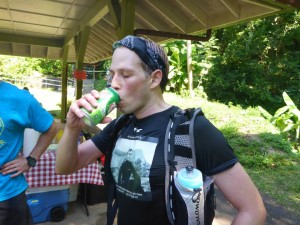
What?
I only puked once on the next leg, a real turning point I was sure, but I was also pretty sure I’d just clocked my slowest marathon time yet, and it was getting dark already. Sometimes I do better at night on hot weather runs, but I wasn’t ready to try caffeine on my stomach, and it would be a long night without it.
My lowest point came two miles into the long climb out of Paradise. I’d only managed 30 miles in 12 hours. The math was clear, and it was against me. I had 24 hours left to run 70 miles, never mind the intermediate cutoffs. Even if I made a full recovery, there was no way I could make up the time.
I felt like a failure. I’d failed myself. I’d failed Finn and Daed. I’d failed everyone who had contributed to the memorial fund because I was running this thing, and everyone back home watching for my name in the online results. I’d failed Conor. Again.
In the dark of the jungle, I sat on the side of the trail and wept. It didn’t matter. I didn’t care who was disappointed, or how fast I ran, or if I finished, or how far I made it at all. I wanted my friend back. I could never run well enough or be good enough or do anything to make that happen.
After a few minutes I looked down at my GPS watch and saw something strange. It told me I was moving very fast, five-minute mile pace or so, and ticking off hundredths of miles as I sat there. I must have landed inches enough off the trail to convince it I had floated up the next switchback. I stood up and started trying to do just that.
This would be okay, I thought. It wasn’t about being perfect, about proving something, or anything more than trying in and with his memory. It was about showing that memory why I try so hard, why I wanted him to be able to join me and learn the same things the same way.
I’d long fantasized about Conor coming out to pace me for a loop at HURT. Even if it didn’t get him into ultrarunning, I knew he’d love the trail and I knew his athletic ass would leave mine in the mud. We’d talked often about what I got from the sport and how it inspired him.
“I think the hard and important part is to take that and apply it to the rest of your life,” he told me once about some hard-won running lessons. He could have some great advice for someone who couldn’t even choose not-death over death.
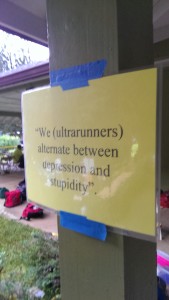
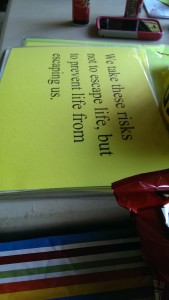
So I wouldn’t finish. So what? There’s no shame in a DNF done right. I’d keep going until someone made me stop.
When I got back to Nu`uanu at mile 33, the station captain told me I looked much better and congratulated me on my attitude. I drank some ginger ale, grabbed some gels and a can of juice for the trail, thanked him, and took off.
A mile out, I sat on a rock and cracked open the juice. As I started to drink, I was elated to feel something I hadn’t in over 24 hours: hunger.
A mile up Nu`uanu Ridge, it all came up again.
I started to ask myself, What would Conor do right now?
Yes, I was mad and disappointed, but I still loved and admired him. What might he do in a situation like this?
Conor would down whatever food was in his pack, puke it up, and sprint to the next aid statoin like nothing happened.
Conor would strike up a conversation with a stranger and find out what they think he should do.
Conor would quit.
Conor wouldn’t be here at all.
Conor would put a gun in his mouth and pull the trigger.
I pressed on, stopping often to rest or to vomit. No matter how loud I turned up my earbuds, I kept hearing how he would have said, “Oh, no-oooh!” when I told him about this. I kept wishing more than anything he were there with me, or anywhere other than sitting on Daed’s shelf in an urn.
At last I accepted I would need to rest until my stomach could recover. It was almost midnight — 18 hours into the race — by the time I made it back to the Nature Center at mile 40. I lay down on a cot where Allen “not that” Lucas checked on me every half hour. After he left, a volunteer medic took over, waking me to sip broth every 10 minutes. Even without moving, my stomach didn’t start to feel settled until 6 a.m., but by then I was too weak and too dehydrated to press on for a third loop.
I’m sure I could have still made them pull me, but not in a good way. Instead I walked over to the timing table, told them I was done, and spent the next twelve hours slowly recovering and watching other runners come back in, victorious or otherwise.
As in my previous adventures, I learned a lot. Like Conor might have said, it wasn’t all about running. It didn’t pan out in the end, or really go well at all, but I’m glad I went.
After all, I didn’t want it to be easy, and I know Conor wouldn’t have either.

